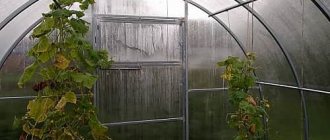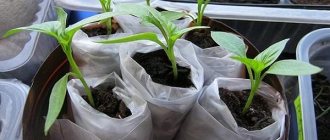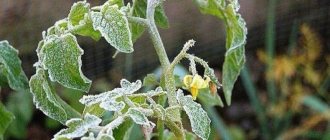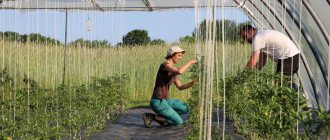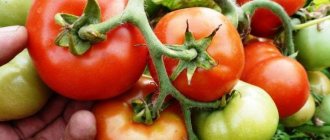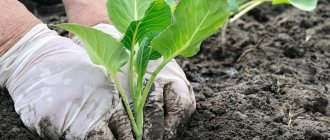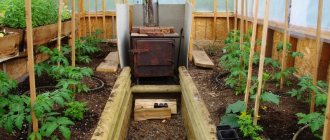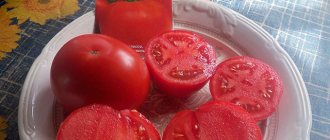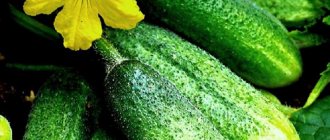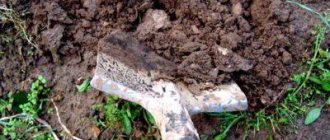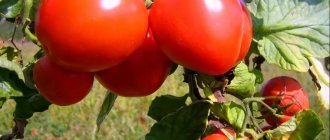Seedlings outgrow for many reasons - due to care errors, unsuitable conditions, or late spring. Experienced gardeners try to prevent this from happening, but they don’t despair at the sight of elongated tomatoes. If you notice in time that tomato seedlings have outgrown, their size can be controlled with special preparations or by adjusting their care. As a last resort, plant it correctly, and the harvest will not be affected or will decrease slightly.
Reasons for overgrowing seedlings
Strictly speaking, outgrowing seedlings and stretching are not the same thing. In tomatoes, the stem lengthens, but this happens for various reasons, and the appearance is different:
- Elongated tomatoes have thin shoots and long internodes. There are few leaves, perhaps 4-5, but they are located far from each other.
- Overgrown with the usual color for the variety, but too tall. The internodes are close, but there are many of them. The thickness of the stem is normal, or slightly thinner than required.
Reasons for pulling tomatoes:
- the seedlings are located too closely, they do not have enough light, the shoot stretches upward;
- the same thing happens if the tomatoes are standing on the windowsill without, or with insufficient lighting intensity;
- excessive watering;
- excess nitrogen fertilizing;
- high temperature – 25° C or more;
- when the seeds just hatched, they were not transferred to a cool place;
- there is no difference between day and night temperatures.
Seedlings outgrow if the seeds are sown too early or spring comes late. It's normal, it just wasn't planted in time, and it's grown big.
There is a lot of time before planting, what should I do?
If there is a lot of time left before planting in the garden - more than 2 decades - the bush can be cut in half, placing the top in a container with water for root growth. After their formation, the tomato is planted in the ground. The lower part, which had to be cut off, will develop a lateral stepson and also turn into a full-fledged bush. When growing two trunks, the yield will even increase. As a result, additional culture units will also be obtained.
This experimental shortening method is also used when the tomato has produced inflorescences. The cut is made almost at the base, leaving three sheets.
Important! This is not the most favorable method; it can lead to slower growth and delayed fruit ripening by 2 weeks compared to non-overgrown specimens. Some also believe that the tops should absolutely not be plucked off before transplanting into the ground.
What to do if the tomato seedlings are overgrown; are there other ways to correct the problems? A simple method is to add soil to a container with seedlings. This is done if the bushes have grown above normal before picking (planting in separate containers). This is an effective measure that does not require large costs and labor. You need to carefully take a spoonful of fertile soil and add it to the sprout.
Important! The cotyledon leaves should remain 2 or 3 cm above the ground. The rest is hidden by the ground.
To implement the method of adding soil, you can use containers that are extended vertically. During and during picking (planting in separate containers), the overgrown seedling is placed in a plastic bottle of the appropriate diameter with the neck cut off and drainage (holes) in the bottom. Tall plastic glasses will also work. You can also increase the height of the container by wrapping it in non-toxic material.
There are many simple ways to take action to combat such developmental disabilities.
Planting tomatoes in a ring
There is another landing option - a ring. Or they make a spiral from a plant, this is a similar method. — You need to dig a round hole up to 25 cm deep and with the same diameter. - Place the root ball in the middle. — The stem carefully, gradually curves into the hole. — Pressing it against the walls, it is brought up, ensuring the vertical position of the top of the head above the pit. — The depression is filled with earth, the center is compacted, and watering is carried out. - Half an hour after the soil has settled, add more soil level with the bed. — Add disease-protective drugs, mulch with a layer of up to 5 cm to prevent drying out and overheating.
It is recommended to plant tomatoes in the evening, on cloudy days, for better adaptation and turgor (tone of leaves and stems). The planting sites are covered with mesh or white material, which can only be opened in the absence of hot sun. You should not get carried away with fertilizers and watering, as this can damage the suction roots that feed the tomato, which will deprive a large part of the early harvest.
Myths about overgrown seedlings
First of all, gardeners who are faced with overgrown seedlings should be reassured. It takes root no worse than the usual one, and produces a good harvest. But only if measures are taken in time and planted correctly.
Otherwise, overgrown tomato seedlings:
- will lie on the ground;
- may break;
- will experience nutritional deficiencies.
As a result, it grows weak and may actually die. You can’t plant bushes as they are.
There is no classification of elongated tomato seedlings by size. No one has done any research on when rooting ability changes. Moreover, there are varieties whose adult bushes grow up to 30 cm, or reach 2 m.
Nevertheless, articles devoted to the problem are replete with assurances:
- slightly overgrown tomatoes have a height of 30 cm and take root well;
- with an average degree (45 cm), it takes root poorly, the brush may extend before transplanting, and will not bloom again;
- at a strong stage of overgrowth - 60 cm, usually does not take root.
Even the smallest tomatoes can bloom if the seedlings are overdried, but not to such an extent that they die. And all the tomatoes will produce a harvest. It’s just that the first, largest and best brush will be lost. Flowers that appear before planting should be removed as soon as possible.
Regarding the catastrophically poor survival rate of seedlings above 60 cm. I would really like to advise ignorant authors of articles to take a ride in the spring on electric trains, minibuses or regular buses going in the direction of their summer cottages. And try to explain why some gardeners bring seedlings that are not just overgrown, but sometimes reach a meter long - the tops stick out from standard jute bags (96 cm). Moreover, it does not seem that they are particularly worried, or are going to ceremoniously bury the tomatoes in the open air.
A little less common is the puzzling statement that when tomatoes are buried, leaves and ovaries fall off. This is exactly the crop for which deep planting is recommended, even for regular-sized seedlings - adventitious roots quickly form on the stem. This is what gardeners have been doing for generations, and they get an excellent harvest. The bushes grow powerful, require less watering and suffer from temperature changes, and better withstand the wind in open ground. And no one has ever had anything fall off from a deep planting. Maybe we need to look for another reason?
Peculiarities
To begin with, let’s look at the concept of “tomato seedlings have outgrown”; perhaps this is not your diagnosis at all.
The ideal bush, ready for planting in open ground, has a height of up to 20 cm. You can already see healthy and elastic leaves and a hard stem with a purple tint. This is an option that every gardener should strive for.
Overgrown or elongated tomato seedlings usually have the following characteristics:
- trunk height from 30 cm and above (30 cm is the normal limit);
- the tomato stem becomes thinner (the shrub lacks light and fertilizer, in the future it will be difficult for it to maintain the weight of the fruit);
- leaves are thin to the touch;
- the root system does not have enough space in the pot;
- You can see the formation of internodes and new leaves, a sign that the shrub is ready to bloom.
What to do with overgrown tomatoes
Tomato seedlings need to be monitored. The first signs of overgrowth are clearly visible - the shoot stretches out. If you take action right away, you can slow down the process and obtain high-quality planting material.
Growth regulators
Gardeners are divided on growth regulators. Those who grow tomato seedlings for sale must use them. With minimal flaws in care, it is guaranteed not to stretch, the stems will be thick and strong.
Others use medications as desired. You just need to carefully read the instructions and strictly follow them. And choose retardants. Otherwise, instead of the expected containment, rapid growth of the aerial part, premature formation of ovaries, or some other effect can be caused.
There are many drugs. You can use the old, well-known Tour, or newer retardants:
- drug Atlet;
- Stocky;
- Antevylegach;
- Support;
- SSS.
They must be used very carefully, avoiding overdose, and only as a last resort. These drugs are classified as pesticides, and are not so harmless.
Care instructions
To prevent seedlings from stretching, you must strictly follow the growing rules. But if the tomatoes have already outgrown, you should:
- Increase lighting. Even on a southern windowsill, tomatoes lack it - sun activity and day length in early spring are insufficient even in regions with a hot climate. It is better to use a phytolamp for illumination; if you don’t have one, use a regular one, placing it not on the side, but above the plants. Tomatoes should have 15-16 hours during the day, the remaining 8-9 hours at night. Illumination in pieces, when it is convenient for the owners, is unacceptable.
- Carry out timely picking in the phase of 2-3 true leaves. If you delay the deadlines so that it is more convenient for inexperienced gardeners to carry out the operation, the tomatoes will definitely outgrow.
- Place bushes further away. When they are arranged in a cluster, the stem reaches towards the light, and the internodes lengthen.
- Reduce watering. But be very careful, since short drying of the substrate causes not only a suspension of growth processes, but also the formation of brushes. It is not recommended to plant tomatoes during flowering - the ovaries will have to be cut off as early as possible.
- Lower the temperature. It is easier for gardeners growing tomatoes in greenhouses with a controlled climate - they can transfer the seedlings there and freely arrange them on the ground. The rest should ventilate the room more often, open the window slightly, protecting the tomatoes with newspaper. At night they can be moved to the coolest place and placed on the floor - cold air accumulates there.
If the reason for the tomatoes to stretch is due to excess nitrogen fertilizers, nitrates can be blocked with unscheduled fast-acting phosphorus-potassium fertilizing. For example, potassium monophosphate.
Plant preparation
Since the tomatoes have not hardened, they need to be hardened off. This will take 5-7 days. Plant the sprouts in the evening or in cloudy weather. The exposure time is gradually increased, starting from 2 hours and ending with a day.
This procedure will prepare the seedlings for exposure to open sun and strengthen the roots.
Another method is to cut the plant into two parts: top and bottom. This will delay the fruit formation process by 2 weeks.
The part in which the roots remain will give rise to a shoot (stepson). The stem with leaves should be placed in a container with water or solution and wait for the appearance of a new root system. Only after this can they be planted in the ground.
This method allows not only to strengthen the seedlings, but also makes it possible to postpone the moment of transplanting the sprouts into the garden or greenhouse if the planned planting time has not yet arrived.
Hardening
Actually, all tomato seedlings need to be hardened off, and not just the ones that are stretched out or overgrown. Otherwise, in open ground it will most likely die before it has time to take root. When planting in a greenhouse, it will hurt for a long time, it will take a lot of time to recover, and part of the crop will not have time to ripen.
7-10 days before moving to a permanent place, the tomatoes are taken outside, where they should spend about 2 hours. Plants protect from sun and wind.
Every day, the time spent in the fresh air of tomatoes is increased first by 1.5 hours, then the difference is increased to 3. On the last night, the seedlings should spend the night outside.
If the tomatoes are in a greenhouse, there is no need to take them out. You can simply open doors and windows for a while.
Appearance
The ideal appearance of tomatoes ready for planting:
- 4 true leaves are formed;
- The stem is dense, with short internodes;
- The leaves are green, elastic;
- The stem color is purple;
- Height up to 20 cm.
If planting time is delayed, the stem stretches and becomes thinner. The internodes increase, and the formation of 3 and 4 pairs of true leaves begins. Bud formation may begin. During transplantation, such tomatoes experience severe stress, which significantly slows down development and delays fruiting.
By appearance you can determine how much the seedlings have overgrown. Slightly overgrown tomatoes have a height of up to 30 cm, 4 leaves, growth occurs at elongated internodes. Such seedlings do not require special measures before transplanting; hardening and good care are sufficient.
Medium overgrown seedlings up to 45 cm high, the formation of 3 pairs of leaves and buds begins. Planted in the ground, it suffers for a long time, the first fruits may be the last.
Important! If the transplant time is delayed, it is necessary to stop watering and move the tomatoes to a cooler room. Severely overgrown tomatoes are more than 50 cm high, have more than 6 leaves, possibly even flowering buds
If you plant such overgrown tomato seedlings in the ground, they can quickly die
Severely overgrown tomatoes are more than 50 cm high, have more than 6 leaves, perhaps even flowering buds. If you plant such overgrown tomato seedlings in the ground, they can quickly die.
Correct replanting in the ground
Tomatoes are planted so that only the first true leaf remains on the surface of the soil. The cotyledons are removed. But many gardeners try to deepen the seedlings as much as possible. This is justified, but it is important not to overdo it. You need to leave at least 2 leaves on the surface until the first flower cluster, where it forms - depends on the variety.
What to do with stretched seedlings? It is necessary to determine at what depth it will be planted, and, at least 24 hours in advance, cut off all the lower leaves so that they do not begin to rot in the ground. The wound surface will heal and infection will not penetrate into it. Planting methods may differ slightly, but, in essence, they come down to two main ones.
When placing overgrown seedlings in holes, it is not recommended to add nitrogen-containing fertilizers. If there are not enough nitrates in the future, they can be added to the root.
Landing lying down
If the seedlings are moderately overgrown:
- Dig an elongated, inclined hole the size of the stem freed from leaves, plus the root system.
- Fill with water.
- When the liquid is absorbed, put the tomato in it. The root should be located in the low part, the top should be on a hill.
- Carefully cover the stem with substrate.
- Lightly squeeze the ground.
- Water generously.
- Mulch with dry soil.
Humus cannot be used - it contains nitrogen. Soon the tomato will straighten up on its own, tall varieties can be tied up.
Spiral landing
If the seedlings are very elongated, it is recommended not to use the previous method. Not because the tomato will not grow well, but in order to save space and reduce labor costs.
Seedlings are planted in a spiral:
- Dig a deep, wide hole.
- Fill with water.
- A lump of earth braided with roots is placed in the center.
- The stem is carefully wrapped in a wide spiral. This does not mean that you need to make a spring out of a shoot. Usually half a turn is enough.
- Gently sprinkle with soil and squeeze.
- Water and mulch with dry substrate.
Advice from experienced gardeners
If your tomato seedlings are outgrowing, you can use the advice of experienced gardeners:
Take very sharp, disinfected scissors and cut off the cotyledons, as well as the lower leaf blades, so that small stumps 10 to 20 millimeters long remain. In this case, the growth of seedlings will slow down for a short time, while their stems will become stronger and thicker. Thanks to phosphorus and potassium, tomatoes become powerful, moreover, these elements do not contribute to the accelerated growth of plants
In this regard, some gardeners recommend using superphosphate and wood ash to feed young tomatoes. To slow down the growth of actively developing plants, they need to be carefully transferred into larger cups, while trying to keep the lump of earth intact. Also, many experienced summer residents advise treating elongated seedlings with Atlet, which can be found in a specialized store. It inhibits plant growth and promotes the development of a powerful root system.
You can spray the bushes with a solution in the evening; it is not recommended to do this during the day, as this may cause sunburn on the foliage.
But it is better to pour 30–50 milligrams of Atleta solution under each plant that has four true leaf blades. For better results, the treatment can be repeated after one and a half to two weeks.
In order for the product to act most effectively, after treatment, the tomatoes are not watered for five days.
If planted early
Tomato seedlings are pruned when they are very overgrown, and there is still a lot of time before they are planted in the ground or greenhouse. This usually happens due to late spring or early sowing of seeds.
To decide how to trim shoots, you need to consider:
- Removing half the stem is used if planting will be done in the near future. Otherwise, the tomatoes may stretch out again.
- When one bottom leaf is left, a stepson quickly forms from its axil. Subsequently, this will be the main escape.
- It is best to leave the bottom 2 sheets. Two stepsons will form, the growth point can be switched to the strongest one, and the other one can be broken off. When they leave one leaf, there is no choice; you have to be content with what grows.
Cut tomato stems can be shortened and the tops placed in water. They will quickly take root. The shoots are planted in individual cups and grown like ordinary seedlings. Their productivity and development will be no different from tomatoes grown from seeds.
Tomato seedlings should not be allowed to overgrow - it is difficult and time-consuming to plant, and you may lose the first cluster of fruit. But if this happens, there is no need to create a tragedy. There are many ways to correct the situation.
The essence of the method
Elongated internodes, pale green mass, stem height of more than 30 cm - all these are signs that the seedlings are outgrowing. Failure to act in this case may lead to loss of future harvest. Seedlings with a height of more than 50 cm are considered to be already very overgrown. Such tomatoes do not adapt well to new conditions. The ability to form ovaries is lost, and the weakened seedlings devote all their strength to survival. The prognosis for overgrown tomatoes that have entered the flowering phase at home is even more pessimistic. Flowering seedlings often die after transplantation.
Growing tomatoes on two roots A strong root system is the key to active growth and development of the plant.
Stimulate the formation of adventitious... You can save dying seedlings using such a radical method as pruning the tops. The essence of the method is to divide the seedling into two parts. To do this, you need to cut off the top third of the stem and place it in water. After a few days, when the tops have taken root, they can be planted again in containers with soil. In order for the root formation process to take place in a shorter time, drugs that stimulate root growth can be added to the water. For example, “Kornevin” or “Heteroauxin”.
You can also get full-fledged seedlings from the lower part of trimmed seedlings. A few days after pruning, the stepsons will begin to produce “hemp”. When the new shoots reach 5-7 cm, you need to select the two strongest stepsons and remove the rest. Thus, you will get bushes already formed into two stems. Subsequent care for them consists of watering, fertilizing and removing side shoots.
Important!
It is recommended to use the top trimming method if the height of the seedlings exceeds 40 cm. For slightly overgrown seedlings (30-35 cm), alternative methods of slowing growth can be used.
Decrease in growth rate
To prevent overgrowth, it is important to keep containers with planted seeds in a room where the air warms up to a temperature of 16-18 degrees Celsius. In this case, irrigation is carried out once every 7 days.
If for some reason it is not possible to plant seedlings in a greenhouse or an open bed, they resort to agrotechnical methods that slow down growth:
- boxes with seedlings are moved to a cool room;
- increase the interval between irrigations, use less water for irrigation.
If the foliage of the seedlings has turned pale, give nitrogen fertilizing. Additionally, the plant is illuminated so as to increase the duration of daylight hours to 16 hours.
Tomato seedlings are thin and long, what should I do?
Many gardeners and gardeners prefer to grow tomato seedlings on their own, without relying on market...
Most Read Reviews
Vermicompost for cucumber Grapes Isabella Grapes Muscat Grapes delight Gooseberry pests Pear early ripening Yellow cherries Seedlings of cucumbers turn yellow How to grow plums How to pollinate tomatoes How to water peppers How to plant a pear How to protect strawberries Calcium nitrate Strawberry Marmalade Strawberry Mashenka Strawberry Roxana Strawberry albion When strawberries bear fruit Raspberry hussar M Ulching cucumbers Mulching of tomatoes crumble berries why the tomatoes are withering why cucumbers disappear why the plum dries why the tomatoes are blackened by vaccination of grapes. Reproduction of lemon. Propagation of the rust of rust on cucumbers mesh for cucumbers. How much blooming lines of gooseberry varieties of sessions of the varieties honey than feed gooseberries than useful grapes black raspberries
Use of drugs
When growing tomato seedlings, modern gardeners use various preparations for treating soil and seeds, treating and preventing diseases, and use anti-stress compounds when transplanting:
- Fitosporin, Glyokladin, Vitaros, potassium permanganate, Maxim. To fight viruses and fungi, seeds are treated with these preparations before sowing and the soil is watered. Phytosporin and pink solution of potassium permanganate are used to prevent fungal diseases. Water the seedlings with them 2-3 times during the growing period.
- Epin. Tomatoes are sprayed with an aqueous solution of Epin after picking to reduce stress.
- Athlete, Kornevin, Zircon. Used on stretched seedlings, stopping their growth. The tomatoes become strong and stocky.
When using chemicals on tomatoes, you must follow the following rules:
- dilute the product in soft water, strictly according to the instructions;
- spray seedlings in cloudy weather or in the evening;
- You need to etch the soil with a solution at a temperature of 50 degrees.
To prevent the tomato seedlings from dying and the gardener’s work not being in vain, you should strictly follow the recommendations for growing the crop.
Great article9 Bad article5
When to prepare a greenhouse?
Basically, the timing of planting seedlings depends on two main factors:
- Factor #1. The climate of a particular area and its agricultural traditions.
- Factor #2. The microclimate of the greenhouse, namely the features of its design and the presence of heating or the installation of “warm beds”).
For example, in the north of the country, where the spring weather until the summer solstice can “delight” with night frosts, it is not worth planting tomato seedlings in a greenhouse too early. And even with well-arranged warm beds - only in April. But it is possible to bring the deadlines closer in any case and under any conditions: build another greenhouse inside the greenhouse. Simply install arcs over the selected bed and cover them with double film.
Another option is to use modern covering material:
How to plant tomato seedlings with a strong root system?
Proven fact: the more developed the root system of a plant, the stronger the seedling itself will be and the larger the future fruits. And with tomatoes this is quite easy to achieve.
Kazarin method
So, this method is called the Kazarin method, and its essence is the dry method of growing greenhouse tomatoes. We initially grow such seedlings in extreme conditions - without watering at all. Then rooting occurs along the stem, which is overgrown with a large number of additional roots. They look for at least a little moisture wherever they can, and this causes them to grow quickly. Moreover, this method is applicable practically only to tomatoes - moisture-loving cucumbers would have withered away long ago from such experiments. But tomatoes, on the contrary, grow stronger and enjoy life.
Here are more detailed step-by-step instructions on how to do this:
- Step 1. We make holes in the form of grooves, no more than 10 cm deep.
- Step 2. Add half a bucket of compost mixed with a glass of ash and 1 gram of potassium permanganate to each hole. Mix with soil.
- Step 3. Now pour half a bucket of water into each hole.
- Step 4. We take the picked seedlings in our hands and visually divide each plant in half. We tear off all the leaves from the lower conventional part.
- Step 5. Place part of the stem without leaves directly into the grooves and cover them with soil. We leave the crown lying on the ground - there is no need to bend it, so as not to break it, it will stretch up on its own and later you will tie it up, like ordinary bushes.
- Step 6. Pour another half a bucket of water on top.
That's all! Throughout the summer, we water the tomatoes only once every two weeks, and then only a little (in the open ground, we don’t water them using this method at all, counting only on rare rains). At first it will be difficult for you to overcome the psychological barrier - the plants will begin to wilt a little, and some leaves will even shrink, but after two weeks the bushes will straighten out and begin to grow a powerful root system. The harvest will be rich and unexpectedly tasty!
